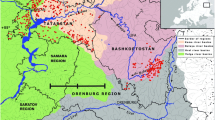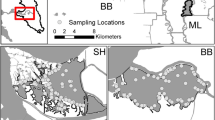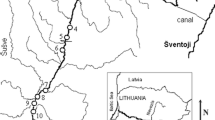Abstract
Fish assemblages and environmental variables were studied in 245 sites in small and mid-sized rivers of the Tatarstan Republic. The basic aim of this investigation was to model the habitat requirements of the 26 most common freshwater fish species at the eastern edge of Europe since the spatial variation of the assemblages of these fish species is little understood there. The impact of environmental factors on species distribution using both presence-absence and abundance data was analyzed with regression methods and ordination methods, which are widely used by European ichthyologists elsewhere. Ordination analysis demonstrated an upstream-downstream gradient of the fish assemblages. Regression analysis indicated that basic predictors of species preference were elevation and “size” of river. For the first time in Eastern Europe, optimum points and niche breadth for fish species along basic environmental gradients were estimated. Niche breadth (tolerance) was highly variable between species. Generally, estimated relationships between environmental factors and the probability of fish presence and abundance were consistent with known fish ecology.




Similar content being viewed by others
References
Abell R, Thieme ML, Revenga C, Bryer M, Kottelat M et al (2008) Freshwater ecoregions of the world: a new map of biogeographic units for freshwater biodiversity conservation. Bioscience 58:403–414
Allan JD, Castillo MM (2007) Stream ecology: structure and function of running waters. Kluwer Academic Publishers, Boston
Andreasson S (1972) Distribution of Cottus poecilopus Heckel and C. gobio L (Pisces) in Scandinavia. Zool Scr 1(2):69–78
Askeyev OV, Askeyev IV, Ananin AN, Tishin DV (2010) A record of nine-spined stickleback (Pungitius pungitius Linnaeus, 1758) in the Kama river basin (Nizhnekamsk, Republic Tatarstan). Povolzhskiy J Ecol 9:103–106
Belliard J, Boet P, Tales E (1997) Regional and longitudinal patterns of fish community structure in the Seine River basin, France. Environ Biol Fish 50:13–147
Bergerot B, Lasne E, Vigneron T, Laffaille P (2008) Prioritization of fish assemblages with a view to conservation and restoration on a large scale European basin, the Loire (France). Biodivers Conserv 17:2247–2262
Brazner JC, Tanner DK, Detenbeck NE, Batterman SL, Stark SL, Jagger LA, Snarski VM (2005) Regional, watershed, and site-specific environmental influences on fish assemblage structure and function in western Lake Superior tributaries. Can J Fish Aquat Sci 62:1254–1270
Brookes A, Gregory KJ, Dawson FH (1983) An assessment of river channelisation in England and Wales. Sci Total Environ 27:97–111
Brown LR (2000) Fish communities and their associations with environmental variables, lower San Joaquin River drainage, California. Environ Biol Fish 57:251–269
Buisson L, Blanc L, Grenouillet G (2008a) Modelling stream fish species distribution in a river network: the relative effects of temperature versus physical factors. Ecol Freshw Fish 17:244–257
Buisson L, Thuiller W, Lek S, Lim P, Grenouillet G (2008b) Climate change hastens the turnover of stream fish assemblages. Glob Chang Biol 14:2232–2248
Cereghino R, Santoul F, Compin A, Figuerola J, Mastrorillo S (2005) Co-occurrence patterns of some small-bodied freshwater fishes in southwestern France: Implications of fish conservation and enviromental management. Ambio 34:440–444
Development Core Team R (2008) R: a language and environment for statistical computing. R Foundation for Statistical Computing, Vienna
Dormann CF, Elith J, Bacher S, Buchmann C, Carl G, Carré G, Lautenbach S (2013) Collinearity: a review of methods to deal with it and a simulation study evaluating their performance. Ecography 36:27–46
Dussling U, Berg R, Klinger H, Wolter C (2004) Assessing the ecological status of river systems using fish assemblages. In: Steinberg C, Calmano W, Klapper H, Wilken RD (eds) Handbuch angewandte limnologie viii-7.4, 20. Erg. Lfg. 12/04. Landsberg, Ecomed Verlagsgruppe, pp. 1–84
Erös T, Botta-Dukat Z, Grossman GD (2003) Assemblage structure and habitat use of fishes in a Central European submontane stream: a patched based approach. Ecol Freshw Fish 12:141–150
Fieseler C, Wolter C (2006) A fish-based typology of small temperate rivers in the northeastern lowlands of Germany. Limnologica 36:2–16
Giller PS (2005) River restoration: seeking ecological standards. Editors introduction. J Appl Ecol 42:201–207
Governmental report on the state of the environment of the Republic of Tatarstan in (1998) (Kazan state university, Kazan, 1999). [in Russian].
Gregory KJ (2006) The human role in changing river channels. Geomorphology 79:172–191
Grenouillet G, Pont D, Hérissé C (2004) Within-basin fish assemblage structure: the relative influence of habitat versus stream spatial position on local species richness. Can J Fish Aquat Sci 61:93–102
Grenouillet G, Roset N, Goffaux G, Breine J, Simoens I, Deleeuw J, Kestemont P (2007) Fish assemblages in European Western highlands and Western plains: a type-specific approach to assess ecological quality of running waters. Fish Manag Ecol 14:509–517
Hammer O, Harper DAT, Ryan PD (2001) PAST: paleontological statistics software package for education and data analysis. Paleontol Electron 4:1–9
Huet M (1949) Aperçu des relations entre la pente et les populations des eaux courantes. Schweiz Z Hydrol Hydrobiol 11:333–351
Huet M (1954) Biologie, profils en long et en travers de eaux courantes. Bull Fr de Piscic 175:41–53
Huet M (1959) Profiles and biology of western European streams as related to fisheries management. Trans Am Fish Soc 88:155–163
Humpl M (2006) Relating fish assemblage variability to environmental gradients in small and mid-sized streams of the Elbe basin (Czech Republic). Electron J Ichthyol 1:15–25
Humpl M, Pivnička K (2006) Fish assemblages as influenced by environmental factors in streams in protected areas of the Czech Republic. Ecol Freshw Fish 15:96–103
Kirchhofer A (1995) Morphological variability in the ecotone—an important factor for the conservation of fish species richness in Swiss rivers. In The Importance of Aquatic-Terrestrial Ecotones for Freshwater Fish. Springer Netherlands, pp. 103–110
Kottelat M, Freyhof J (2007) Handbook of European freshwater fishes. Publications Kottelat, Cornol
Kruk A, Lek S, Park YS, Penczak T (2007) Fish assemblages in the large lowland Narew River system (Poland): application of the self-organizing map algorithm. Ecol Model 203:45–61
Kutner MH, Nachtsheim CJ, Neter J (2004) Applied Linear Regression Models, 4th edition, McGraw-Hill Irwin
Küttel S, Peter A, Wüest A (2002) Temperaturpräferenzenund -limiten von fischarten schweizerischer fliessgewässer. EAWAG, Kastanienbaum
Lamouroux N, Capra H, Pouilly M, Souchon Y (1999) Fish habitat preferences in large streams of southern France. Freshw Biol 4:673–687
Lasne E, Bergerot B, Lek S, Laffaille P (2007) Fish zonation and indicator species for the evaluation of the ecological status of rivers: example of the Loire basin (France). River Res Appl 23:877–890
Logez M, Pont D (2011) Variation of brown trout Salmo trutta young-of-the-year growth along environmental gradients in Europe. J Fish Biol 78:1269–1276
Logez M, Bady P, Pont D (2012) Modelling the habitat requirement of riverine fish species at the European scale: sensitivity to temperature and precipitation and associated uncertainty. Ecol Freshw Fish 21:266–282
Lyons J (1996) Patterns in the species composition of fish assemblages among Wisconsin streams. Environ Biol Fish 45:329–341
Magalhaes MF, Batalha DC, Collares-Pereira MJ (2002) Gradients in stream fish assemblages across a Mediterranean landscape: contributions of environmental factors and spatial structure. Freshw Biol 47:1015–1031
Mastrorillo S, Dauba F, Belaud A (1996) Microhabitat use by minnow, gudgeon and stone loach in three rivers in southwestern France. Ann de Limnol - Int 121 J Limnol 32:185–195
Matthews WJ (1998) Patterns in freshwater fish ecology. Chapman and Hall, Norwell, New York
Matthews WJ, Robinson HW (1988) The distribution of the fishes of Arkansas: a multivariate analysis. Copeia 1988:358–374
Melcher A, Schmutz S, Haidvogl G, Moder K (2007) Spatially based methods to assess the ecological status of European fish assemblage types. Fish Manag Ecol 14:453–463
Naiman RJ, Melillo JM, Lock MA, Ford TE, Reice SE (1987) Longitudinal patterns of ecosystem processes and community structure in a subarctic river continuum. Ecology 68:1139–1156
Noble RAA, Cowx IG, Starkie A (2007) Development of fish-based methods for the assessment of ecological status in English and Welsh rivers. Fish Manag Ecol 14:495–508
Oberdorff T, Porcher JP (1992) Fish assemblage structure in Brittany streams (France). Aquat Living Resour 5:215–223
Oberdorff T, Guilbert E, Lucchetta C (1993) Patterns of fish species richness in the Seine River basin, France. Hydrobiologia 259:157–167
Oberdorff T, Hugueny B, Vigneron T (2001a) Is assemblage variability related to environmental variability? An answer for riverine fish. Oikos 93:419–428
Oberdorff T, Pont D, Hugueny B, Chessel D (2001b) A probabilistic model characterizing fish assemblages of French rivers: a framework for environmental assessment. Freshw Biol 46:399–415
Oksanen J, Blanchet FG, Kindt R, Legendre P, Minchin PR, O’Hara RB, Simpson GL, Solymos P, Stevens MHH, Wagner H (2013) Vegan: Community Ecology Package. R package version 2.0–9
Pekarik L, Svatora M, Cerny J, Kosco J (2011) Longitudinal structures of fish assemblages in a minimally disturbed stream. Biologia 66:886–893
Penczak T, Galicka W, Głowacki Ł, Koszaliński H, Kruk A, Zięba G, Kostrzewa J, Marszał L (2004) Fish assemblage changes relative to environmental factors and time in the Warta River, Poland, and its oxbow lakes. J Fish Biol 64:483–501
Pires AM, Cowx IG, Coelho MM (1999) Seasonal changes in fish community structure of intermittent streams in the middle reaches of the Guadiana Basin (Portugal). J Fish Biol 54:235–249
Poff NL, Allan JD, Bain MB, Karr JR, Prestegaard KL, Richter BD, Sparks RE, Stromberg JC (1997) The natural flow regime: a paradigm for river conservation and restoration. Bioscience 47:769–784
Pont D, Hugueny B, Oberdorff T (2005) Modelling habitat requirement of European fishes: do species have similar responses to local and regional environmental constraints? Can J Fish Aquat Sci 62:163–173
Reshetnikov YS, Dyakina TN, Korolev VV (2012) Changes in the structure of ichthyofauna in water bodies of Kaluga oblast over the past few decades. Russ J Ecol 43:52–61
Santoul F, Mengin N, Cereghino R, Figuerola J, Mastrorillo S (2005) Environmental factors influencing the regional distribution and local density of a small benthic fish: the stoneloach (Barbatula barbatula). Hydrobiologia 544:347–355
Schlosser IJ (1982) Fish community structure and function along two habitat gradients in a headwater stream. Ecol Monogr 52:395–414
Sheldon AL (1968) Species diversity and longitudinal succession in stream fishes. Ecology 49:193–198
Strayer DL, Dudgeon D (2010) Freshwater biodiversity conservation: recent progress and future challenges. J N Am Benthol Soc 29:344–358
Sutela T, Vehanen T, Jounela P (2010) Responses of fish assemblages to water quality in boreal zone. Hydrobiologia 641:1–10
Taylor CM, Warren ML (2001) Dynamics in species composition of stream fish assemblages: environmental variability and nested subsets. Ecology 82:2320–2330
ter Braak CJF, van Dam H (1989) Inferring pH from diatoms: a comparison of old and new calibration methods. Hydrobiologia 178:209–223
Torgersen CE, Baxter CV, Li HW, McIntosh BA (2006) Landscape influences on longitudinal patterns of stream fishes: spatially continuous analysis of fish-habitat relationships. In: Hughes R, Wang L, Seelbach P (eds) Influences of landscapes on stream habitats and biological communities, American Fisheries Society. Bethesda, MD., pp. 473–492
Vannote RL, Minshall GW, Cummins KW, Sedell JR, Cushing CE (1980) The river continuum concept. The river continuum concept. Can J Fish Aquat Sci 37:130–137
Vehanen T, Sutela T, Korhonen H (2010) Environmental assessment of rivers using fish data – a contribution to water framework directive. Fish Manag Ecol 17:165–175
Verneaux J (1977) Biotypologie de l’écosystème “eau courante”. Détermination approchée de l’appartenance typologique d’un peuplement ichtyologique. C R Acad Sci (Life Sci) 284:675–678
Vlach P, Dušek J, Švatora M, Moravec P (2005) Fish assemblage structure, habitat and microhabitat preference of five fish species in a small stream. Folia Zool 54:421–431
Acknowledgments
Many thanks go to Carol Barker, Olga Butorina and to professor Tim Sparks for English revision of the manuscript. Our special thanks to N.A. Chizhikova for consultation on statistical analysis. We thank the editor and two unknown referees for their comments on an earlier version of this manuscript. We declare that the fish were caught under a survey permit of the Russian Federal Agency for Fisheries.
Author’s contributions
OA performed the field and laboratory work and wrote the manuscript with assistance from IA and AA. OA and AA conducted the data analyses. IA, AA, SM and NY organized the logistics for the fieldwork, participated in the collection of data and helped to draft the manuscript. OA coordinated and supervised the study. All authors read and approved the final manuscript.
Author information
Authors and Affiliations
Corresponding author
Rights and permissions
About this article
Cite this article
Askeyev, O., Askeyev, I., Askeyev, A. et al. River fish assemblages in relation to environmental factors in the eastern extremity of Europe (Tatarstan Republic, Russia). Environ Biol Fish 98, 1277–1293 (2015). https://doi.org/10.1007/s10641-014-0358-0
Received:
Accepted:
Published:
Issue Date:
DOI: https://doi.org/10.1007/s10641-014-0358-0




